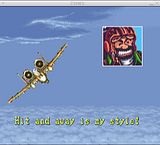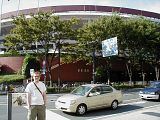This morning, I decided to take the train out to Chiba (an eastern suburb of Tokyo) to see what the commute would be like were I to take a job with Amazon.co.jp, one of the companies I am interviewing with. I left our apartment at about 10:30 (oh, it is so nice being unemployed; rolling out of bed at 09:30, taking a long hot shower, checking my email and reading the morning "news") and walked to the nearby Ishikawa-cho train station. There, I bought a ticket for Yokohama Station for 150 yen and inserted it in the automatic turnstile, which spit it out on the other side, with a hole punched in one side of the ticket. (For all of you who live in the vicinity of Washington, DC--and I am including all Virginians in this description--this is very much like riding the Metro, except it costs less.) I then turned left and took the escalator up to platform number 1, where I waited for the 10:38 local train to Yokohama-
eki (station).
There are two stops--Kannai and Sakuragi-cho--before Yokohama on the local train. Once I reached Yokohama, I walked down the stairs from platform 4 and then walked back up a different set of stairs to platform 8. There, I waited for the
tokkyuu--Special Express--to Tokyo-
eki on the JR (Japan Railway) Toukaidou Line. The train came at 10:50, and from there it was a 20 minute ride to Tokyo-
eki, which is probably the world's largest train station. Maybe someone familiar with Paddington Station in London can relate?
This particular express was a little unusual in that it actually had Amtrack-style seats: two on each side with an aisle down the middle. Japanese short-haul trains usually have only benches along the walls, with the majority of the car being standing room. My first mistake, when faced with this novelty, was to get on the last car of the train and sit down. Shortly after the train got underway, and announcement came on over the speakers that cars 1 and 2 were for passengers with reserved seats only. Cars 3, 4, 5, and 6 were "general admission". Of course, I was currently in car 1, so I had to move down. Unfortunately, I was in the window seat, and an ancient
obaasan (grandmother) had seated herself in the seat next to me. Not wanting to make her get up to let me by, I had to wait until the ticket taker came to our row and directed the
obaasan to move on to car 3 or higher. I followed her down, and when she came to the door that separated cars 1 and 2, I was actually able to be of service. She was tugging at the door handle, but it would not open. I noticed a button to the left of the door which had the
kanji (Chinese character) for
mousu--push--on it, so I said, "
Sumimasen. Kono baten wo ousu to, doaa ga aku deshou...," which means, "Excuse me. If you push this button, it appears that the door will probably open." So she did, it did, and she said, "
A, sou desuka. Sumimasen," meaning, "Oh, so it does. Thank you / I'm sorry."
After finding a legal seat in car 3, I settled in for the trip. The train had two stops before Tokyo: Shinagawa and Shinbashi. Before long, the ticket taker came by again, and asked me where I was going. I handed him my ticket from Ishikawa-cho to Yokohama, and told him that I was going to Tokyo. Apparently, this was a mistake, as he charged me a staggering 890 yen ($8.25 or so). I think I should not have given him the Ishikawa-cho ticket, because on the receipt he gave me, it listed the cost of the train from Yokohama to Tokyo at 500 yen, then showed another 390 yen for Ishikawa-cho to Tokyo. This after I had already paid my fare from Ishikawa-cho to Yokohama. Oh well, live and learn, they say.
Once I arrived at Tokyo-
eki, I had a 500 metre walk to the platforms for the Keiyou Line, which I needed to take to the Amazon Distribution Centre in Chiba. Luckily, there were moving sidewalks and escalators, so the walk only took about five minutes. Once I got to the platforms, I located the ticket machines, and then looked around for the map that told me how much fare I needed to put on my ticket to ride to Ichikawa-Shiohama Station. Upon not finding such a map, I asked the chap at the ticket window, who referred me to a sign that said, "Please Pay Fare at Destination" (yes, it was translated into English for me--the Japanese are pretty good at providing English-language signage at train stations, at least in the big cities). I made the mistake (apparently) of believing this sign, and headed down to the platform to catch the next train.
The next train, it turned out, was a local, but it did not look like there was an express coming soon, so I went ahead and boarded it. This was a conventional short-haul train, and it was already full enough that I could not get a seat. This is the normal state of affairs, however, so I did not care. In fact, when I
do manage to get a seat, that is a cause for celebration! The local, stopping as it did at every station between Tokyo and Ichikawa-Shiohama, took about 20 minutes to reach my destination. Once it did, I got off and headed down the stairs to the exit (Ichikawa-Shiohama is small enough that it has only one exit; several of the stations in Tokyo, by comparison, have 20 or so). I approached the ticket window and told the chap within that I had come from Tokyo. I expected him to just tell me the fare to pay, since the sign had indicated that this was how it worked on this line, but the attendant just looked at me blankly. I explained that I did not have a ticket, that they had told me at the ticket window in Tokyo to pay here. He scowled at me, and said, "
Kippu ga nai to dame desu yo!" meaning, "If you don't have a ticket, it is impossible [to ride the train] [you idiot foreigner]!" I was a bit taken aback, so I tried to explain again that there was not a fare map, and that the ticket window attendant had told me to pay at my destination. The guy repeated that I should have bought a ticket or not gotten on the train at all, at which point I rolled my eyes and asked, "
Ikura desu ka?"--"How much [is it] [to ride the train from Tokyo to here] [you insensitive clod]?"--which was certainly a bit rude of me, but I was getting no love from this belligerent chap. Scowling disapprovingly, he told me it was 290 yen, which I paid. I left quickly, but not before he had a chance to repeat again that in Japan you
always bought the ticket before getting on the train (which is, for the curious, not true at all).
Having braved all of the hazards of rail travel in Japan, I was faced with a new difficulty: how to find the Amazon building from the train station. The chaps who interviewed me had told me that:
- the Amazon facility was a three-minute walk from the station, and
- you cannot miss it, as it is the largest building visible from the station, and has AMAZON.CO.JP written on it in large letters
Of course, none of this turned out to be true, at least according to Newtonian physics. So I walked around for about an hour in the vicinity of the station, but still could not find the building. At this point, you may be asking, "Come on! How hard is it to find a building?" In Japan, the answer is: ranging from pretty hard to damn near impossible! You understand the concept of street names, right? Whereby looking at the signs at intersections, the driver or pedestrian can ascertain which street he is currently on, and furthermore, the name of the street that is perpendicular to it. Street names, therefore, turn out to be quite convenient for directions, because you can say things like: "From the station, turn right onto Cherry Avenue. At the second traffic light, turn left onto Orchard Street. When you see the big Crazy Ivan's Vodka Empire sign on your left, turn left just beyond it onto Chekhov Boulevard. Our building is 123 Chekhov Boulevard, which will be on your left, and it has a big yellow Foo Bar Corporation logo emblazoned on it."
Not bad, right? Well, in Japan, most streets do not have names. And furthermore, while some buildings might have numbers, there is no guarantee that 123 is located anywhere near 121, 122, 124, or 125, as you might suspect. In fact, in Japan, you might find 123 next to 1028 and 772, and 124 three kilometres down the road, in a random direction of your choosing. So directions in Japan usually sound more like this: "From the station, turn right. There should be a 7-11 on your right, and a Tokyo-Mitsubishi Bank ATM across the street on your left. Walk down the road, past the Family Mart, until you get to an intersection with a Esso gas station on the right. There should be a traffic light here. Turn left, crossing the street towards the Yes! Yes! Yes! pachinko parlour. When you see the big Kureji Ibanzu Boduka Inpaya sign on your left, turn left at the next street. Our building is about 200 metres from the intersection, just past the Circle K with the porn vending machine outside. It has a big yellow Foo Bar Corporation logo emblazoned on it."
What usually happens is you follow the directions as best you can, stopping frequently at convenience stores and asking them if they know where your destination is. Using this method, you can usually home in on your target, and hopefully even find it at some point.

Of course, I had no directions, and no-one in the industrial zone of Chiba had any idea where Yet Another warehouse was, so I just wandered aimlessly. At least I was able to take a picture of the city across the bay (left). Luckily, there is a shuttle bus from the station to the Amazon Distribution Centre, so I can take it the first couple of days until I know how to walk there, if I get the job.
Defeated for today, I returned to Yokohama via rail by buying a ticket for 290 yen at Ichikawa-Shiohama Station (enough to get me to Tokyo), transferring to the Toukaidou Line to get back to Yokohama Station, and then transferring to the JR Yokohama Line to get to Kannai Station. At Kannai, I got off the train and used the fare adjustment machine right in front of the ticket turnstiles. You put your original ticket in (my ticket from Ichikawa-Shiohama) and sometimes tell the machine which line you took, and it tells you how much you owe, in addition to the amount on your original ticket. In this case, I owed 490 yen, so I put in a 500 yen coin (yes, there is a coin worth roughly $5 in Japan!) and received an adjusted ticket and a 10 yen coin for my troubles.
I left the station and proceeded directly to Moss Burger (I did not pass Go, nor did I collect $200, if you were waiting for that joke), a "Fine Japanese Coffee and Burger" joint. I ordered the Moss Burger Set, which consists of a Moss Burger (which is a quarter pound burger, topped with chili, onions, and tomato), a drink, and a combination french fry / onion ring box. At 630 yen, it is a bit more pricey than McDonald's, but much more tasty. This particular Moss Burger has a counter at which you can sit and look out the front window at the sidewalk, which I did, as this is the same sidewalk that Lyani uses to walk home from school, and it was almost time. I did not see Lyani while I was eating, but I did see Tyler, a colleague of hers who happens to live next door to us at Toriumi Haimu. I left Moss Burger and waited at the corner for the light at the crosswalk to turn green.
That was when I felt a tap on my shoulder, and turning around, whom to my wondering eyes did appear but Lyani. We walked home together, at which point she took a nap and I wrote this blog entry. The end.
 I started a load of laundry--boy it is nice to finally have a laundry machine in our apartment (actually, ours is on our rear balcony)--then sat down to play a little UN Squadron on ZSNES an Open Source Super Nintendo emulator. Ian, I know you remember many happy hours spent with UN Squadron on your SNES!
I started a load of laundry--boy it is nice to finally have a laundry machine in our apartment (actually, ours is on our rear balcony)--then sat down to play a little UN Squadron on ZSNES an Open Source Super Nintendo emulator. Ian, I know you remember many happy hours spent with UN Squadron on your SNES! The weather was wonderful for walking (23 degrees and sunny), so I first walked past Yokohama Station (pictured at left; click on it to see a slideshow of pictures from around Yokohama) to the Naka Ward Office, to peruse their brochures and maps. From there, I walked to Kannai Station and boarded a train for Yokohama. After taking care of my business at the Citibank ATM, I caught a train from Yokohama Station to Yamate Station, which is one stop east of our station, Ishikawa-cho. From there, I attempted to head south-east to the Naka Ward Public Library, but managed to get pretty lost in the maze-like hills of Yamate. Luckily, I managed to take some pretty decent pictures and had a lovely walk anyway. The highlight of said walk had to be in Honmoku, when I was walking down the street behind three shougaku-sei (elementary school) boys. They were just chatting, but all of a sudden, they started, in unison, to hum the "Imperial Death March" from "Star Wars". You know, Darth Vader's theme? They continued to do this for three blocks or so, and they went through the song. They did not just repeat the main theme. And this was a theme from a trilogy of movies that was made a good ten years before they were even born! Amazing! I should have joined in, but I chickened out.
The weather was wonderful for walking (23 degrees and sunny), so I first walked past Yokohama Station (pictured at left; click on it to see a slideshow of pictures from around Yokohama) to the Naka Ward Office, to peruse their brochures and maps. From there, I walked to Kannai Station and boarded a train for Yokohama. After taking care of my business at the Citibank ATM, I caught a train from Yokohama Station to Yamate Station, which is one stop east of our station, Ishikawa-cho. From there, I attempted to head south-east to the Naka Ward Public Library, but managed to get pretty lost in the maze-like hills of Yamate. Luckily, I managed to take some pretty decent pictures and had a lovely walk anyway. The highlight of said walk had to be in Honmoku, when I was walking down the street behind three shougaku-sei (elementary school) boys. They were just chatting, but all of a sudden, they started, in unison, to hum the "Imperial Death March" from "Star Wars". You know, Darth Vader's theme? They continued to do this for three blocks or so, and they went through the song. They did not just repeat the main theme. And this was a theme from a trilogy of movies that was made a good ten years before they were even born! Amazing! I should have joined in, but I chickened out.
 I uploaded some pictures of our apartment to Kodak's EasyShare Gallery, so you guys can finally see them.
I uploaded some pictures of our apartment to Kodak's EasyShare Gallery, so you guys can finally see them. 